Japan
Wood Products Prices
Dollar Exchange Rates of 10th
Dec
2021
Japan Yen 113.38
Reports From Japan
Win the race against Omicron to
secure growth
In its latest report on Japan's economic and financial
situation the OECD noted that "losing the race against new
variants could result in renewed states of emergency being
declared delaying the recovery," despite progress in the
government's vaccine rollouts. The OECD projected in its
latest economic outlook that the Japanese economy will
grow 1.8 percent in 2021 and 3.4 percent in 2022.
Under virus emergencies, people in Japan had been asked
to refrain from making nonessential outings although the
requests were nonbinding. The OECD added that the
Omicron variant could "aggravate" the employment
prospects of young people after graduating.
See:
https://www.oecd.org/newsroom/japan-broaden-the-digitaltransition-to-strengthen-economic-recovery-from-covid-19-saysoecd.htm
Economy declined 3.6% in the third quarter
The Japanese government says the country's latest
economic downturn bottomed out in May 2020 during the
first wave of the pandemic. A Cabinet Office expert group
said Japan's economy took a turn for the worse on the back
of trade disputes between China and the United States at
the same time a state of emergency was in place for much
of the country, hurting employment and manufacturing.
The group said the downturn extended for 19 months
making it the fourth longest recession since the end of
World War Two.
The economy began to show signs of recovery picking up
in June 2020 but the recovery remains weak with GDP
dropping for three consecutive months to September 2021
and even in comparison with past recovery periods the
current upturn appears to be stalling.
Japan's economy shrank slightly faster than initially
reported in the third quarter, as a sharp rise in local Covid-
19 cases hit private consumption and a global chip supply
shortage hurt corporate sentiment. The economy declined
an annualised 3.6% in the third quarter of this year mainly
due to a larger than expected fall in private consumption
which makes up more than half of GDP.
See:
https://www5.cao.go.jp/keizai3/chiiki/chiiki.html
and
https://www.businesstimes.com.sg/government-economy/japandowngrades-q3-gdp-on-deeper-hit-to-consumer-spending
¡®Shrinkflation¡¯ ¨C Japan¡¯s contribution to economic
jargon
Because consumer prices and wages in Japan have
remained remarkably unchanged for the last 20 years
companies now do all they can to avoid increasing prices
for fear of losing out to competitors. A Japanese website
(www.neage.jp) tracks price changes and hidden price
hikes whereby the product is reduced in size the price
stays the same and has introduced the term ¡®shrinkflation.
In Japan, the impact of deflation means it is difficult to
raise prices directly and that is a headache for the
government which wants to see modest inflation, an
essential component to a virtuous spending cycle to drive
economic growth.
Good news on covid ¨C bad news on energy prices
Despite the rapid decline in the number of Covid-19
infections across the country November consumer
confidence, as recorded by the Japanese Cabinet Office,
was unchanged compared to a month earlier. The main
concern of consumers, it appears, is rising electricity and
gasoline prices.
Of the four component indicators, that for overall
livelihood and willingness to buy durable goods fell for
the second consecutive month. Indicators for income
growth and employment improved for the third straight
month in November.
See:
https://www.japantimes.co.jp/news/2021/12/04/business/economy-business/japan-shrinkflation-economy/
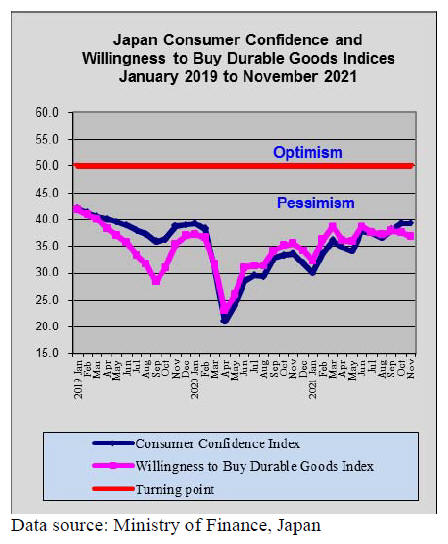
Wage increases or else companies told
In an effort to boost wages and drive domestic
consumption the government has threatened to deny some
tax breaks to big companies that do not hike wages while
boosting deductions for those that do. This proposal is
included in the final draft of the government¡¯s annual tax
reform plan.
Wages in Japan have stayed largely flat over the past 30
years aggravating deflation. The tax plan is part of the
Prime Minister¡¯s focus on distributing wealth to
households.
Large companies that raise wages by 4% from the
previous year will get deductions of up to 30% of taxable
income, up from the current maximum of 20%.
Small firms that raise wages by 2.5% will qualify
for a tax
deduction of up to 40% up from the current 25%.
Companies that do not raise wages will not be able to
claim tax deductions a wide range of expenditure.
See:
https://www.reuters.com/world/asia-pacific/japan-givemassive-tax-breaks-companies-that-lift-wages-draft-plan-2021-12-08/
Title
Housing in Japan is cheap relative to that in other
developed economies because of the country's almost
deregulated housing policies which has allowed the
number of houses to grow such that never has housing
demand overtaken supply which has kept prices low.
Housing starts are a barometer of the overall health of an
economy; if starts rise then it means developers and their
bankers are confident enough to build houses and assume
there will be buyers.
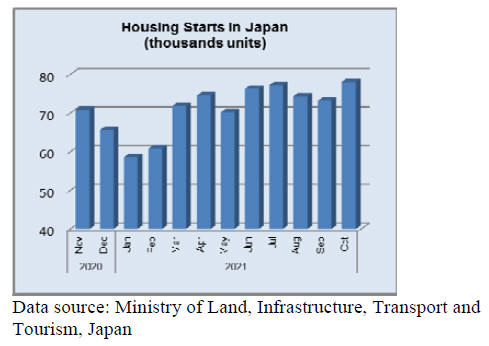
Prices rising as weak yen pushes up import
costs
For most of 2021 the yen has weakened against the US
dollar mainly because of Japan¡¯s continued stuggle with
Covid-19, rising commodity prices and higher US
Treasury yields which pushed the dollar higher. The weak
yen is behind the 9% rise in wholesale prices in
November, the steepest advance for years.

Import update
Wooden door Imports (HS441820)
As was the case in September China accounted for 53% of
Japan¡¯s October 2021 imports of wooden doors. The other
top shippers to Japan were; the Philippines (14%), the US
(17%) and Sweden (11%). There were very few shipments
of wooden doors from SE Asian producers.
Year on year, October wooden door imports (HS441820)
were 6% lower than in than in 2020 and still below the
value of October 2019 imports. After three consecutive
monthly declines the value of Japan¡¯s wooden door
imports rose in October. Theree was only a slight
difference between the value of September and October
2021 imports of wooden doors.

Wooden window imports (HS441810)
After the dramatic decline in the value of August imports
of wooden windows (HS441810) there was a modest
recovery in September and this extended into October.
Month on month there was a 12% rise in the value of
October imports.
Year on year there was little change in the value of
October imports. Despite the rise in October the value of
imports of wooden windows is still well below the levels
seen in October 2019.
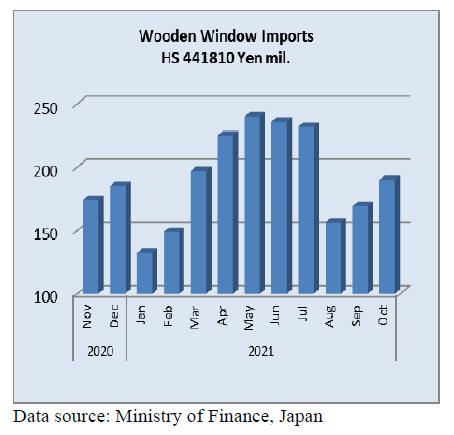
Over 80% of Japan¡¯s imports of wooden windows in
October came from shippers in just two countries, China
(58%) (42% in Sept..) and the Philippines 26% (18% in
Sept.). Shippers in these two countries continue to
dominate Japan¡¯s imports of wooden windows.
Assembled wooden flooring imports
The value of assembled flooring (HS441471-79) imports
has been erractic since mid-2021 but there is an underlying
upward trend in the value of imports. Year on year, the
value of Japan¡¯s imports of assembled wooden flooring in
October rose a massive 72% (c.f. 22% in September and
the value of imports had recovered to the level reported for
October 2019.
Imports of HS441875 was the main category (77% Oct.
c.f. 72% in Sep.) with most coming from China (46%) and
Vietnam (24%). Shipments from Thailand and Malaysia
were small.
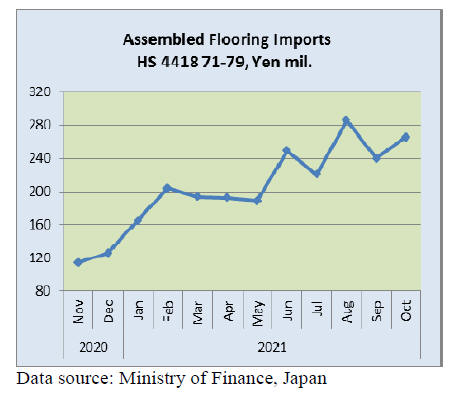
Plywood imports
The volumes of Japan¡¯s plywood imports rose 25% in
October compared to a month earlier and at 169,163 cu.m,
were higher than in both 2020 and 2019. In October all
four shippers of plywood, Malaysia, Indonesia, China and
Vietnam posted year on year gains but compared to the
volume of shipments in September shippers in China and
Indonesia saw a slight decline while imports from
Malaysia and Vietnam rose.
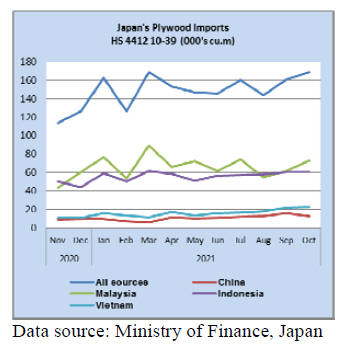
From mid 2021, except for the dip in August, the
volume
of Japan¡¯s plywood imports has shown an upward trend.
Shipments from Malaysia have risen for two consecutive
months and there has been a steady increase in the volume
of plywood imported from Vietnam.
In October 2021 it was only China that saw a drop in the
volume of plywood shipments to Japan.
Of all shipments in October HS441231 accounted for over
87% while imports of HS441234 and HS441239 acounted
for around 4% each.
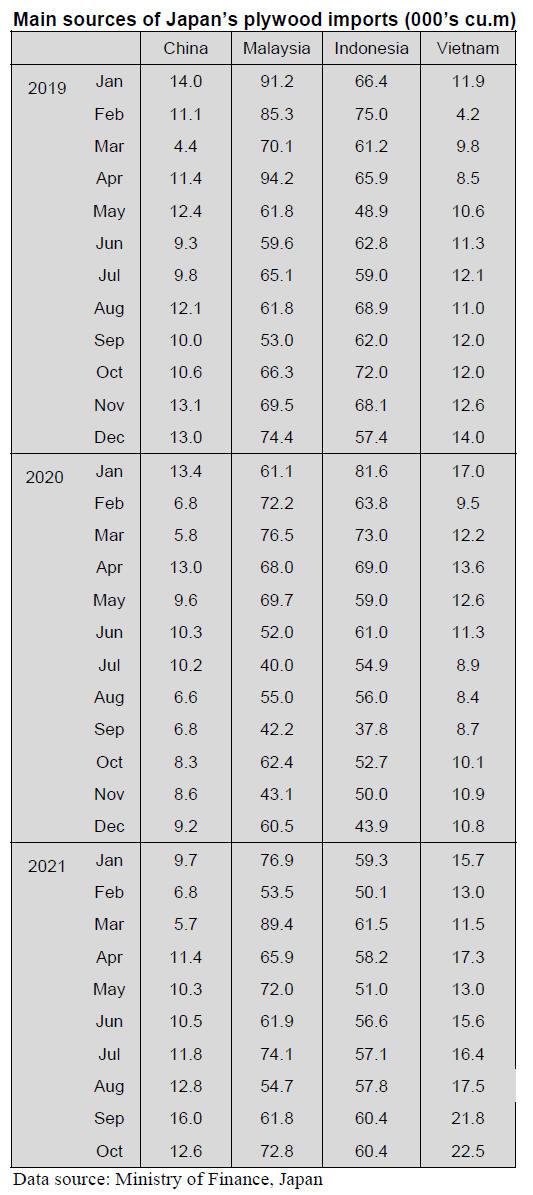
Trade news from the Japan Lumber Reports (JLR)
The Japan Lumber Reports (JLR), a subscription trade
journal published every two weeks in English, is
generously allowing the ITTO Tropical Timber Market
Report to reproduce news on the Japanese market
precisely as it appears in the JLR.
For the JLR report please see:
https://jfpj.jp/japan_lumber_reports/
Price index trend by the bank of Japan
Soaring wood products¡¯ since last spring pushed total cost.
In August, wood products are number one item of inflation
among other items then in September, imported wood
products are number one so escalated prices of wood
products are conspicuous. After spiraling wood products
prices in producing regions of Europe and North America
simmered down, which lasted for six months, imported
cost of wood products continue high because of
weakening yen¡¯s exchange rate.
It is too early to judge if this is new era of wood market
but one favorable thing is that high cost imported wood
products stimulated demand of domestic wood products.
The bank of Japan disclosed price index of domestic
businesses in October based on average of 2015 is 100.
October index is 107.8, 8.0% up from October last year.
This increase is first time since January 1981, 40 years and
nine months. 1981 is peak year of second oil shock.
Escalation of prices is brought by confusion of geopolitics
like soaring oil prices.
In this year, the prices increased by confusion of supply
chain by COVID 19 epidemic, unstable supply of
materials as a result of confusion of container cargo
handlings. This collapsed balance of supply and demand
and the prices soared. Wood products are not listed as
inflation factor until last March then it started impacting
price increase since last April.
In August, overall price increase is zero but wood
products¡¯ contribution factor is 0.06% together with steel
products, which exceeded metal and plastic. Meantime,
prices of imported wood products surpassed 2015 level
since last March and in July, it is 132.6 and 164.5 in
October. By items, European laminated products and
lumber and North American lumber.
Price escalation this year is brought by demand explosion
in North America, Europe and China. Wood demand in
Japan is not so bad with new housing starts of level of
800,000 units, which is more than 2020.
Higher materials¡¯ cost contributed higher corporate profit.
Wood products prices are now decided by international
factors and Japanese domestic wood is now becoming
international since Japan exports over one million cubic
meters a year, which is the largest exporting country in
Asia, surpassing Malaysia.
Following chart shows trend of index month by month
through October. Index of wood products compared to
overall price index is getting higher in the second half of
the year. Rank shows how wood products contribute
among other products.

Second quarter performance of housing
companies
Major house builders recorded higher sales and higher
profit despite inflation of building materials. Number of
new starts in the same quarter last year dropped by
COVID 19 epidemic then housing starts recovered. For
major builders of order made houses, result is better than
2020 but lower than 2019.
Orders for builders of unit built for sale did not drop in
2020 and many gained more. In 2021, wood and steel
products prices soared but many absorbed inflated portion
by themselves and recoded higher profit yet.
It is rough estimate but for Sekisui house, wood prices for
detached and rental units are about five billion yen more
and steel prices are about two billion yen more up until
last July and it started passing higher cost onto sales
prices. Sekisui Chemical Housing¡¯s steel prices increased
by five billion yen but it has not passed to the sales prices
yet. Daiwa House says steel prices increased by almost
three times and it will put it onto sales prices from now on.
Since last year, people¡¯s sense or standard of value for
living and working has changed by COVID 19 pandemic.
By increase of remote works, people started moving out of
populated areas and demand for housing in suburban areas
increased.
In Tokyo region, demand for units built for sale started
increasing since May 2020. Builders of units built for sale
could sell already built units without any discount and the
inventory rapidly decreased.
Plywood
Supply shortage of domestic softwood plywood continues
through the year and precutting plants are forced tight rope
operation and very cautious of taking new orders. Other
structural wooden board has no extra supply to replace
plywood so there is no substitution.
The manufacturers struggle to secure material logs and
imported logs like North American Douglas fir are also
hard to have. Also adhesive prices are escalating so major
manufacturers decided to raise the prices of 12 mm 3x6
panel by 200 yen per sheet.
Market prices of imported hardwood plywood continue
climbing because the suppliers¡¯ export prices keep
escalating and the yen¡¯s exchange rate is weakening. In
supplying regions, rainy season started. Local plywood
mills didn¡¯t have time to build up log inventory before
rainy season started. Higher adhesive prices are another
factor to increase the prices. Container shortage increases
transportation cost.
Domestic logs and lumber
Demand of domestic lumber is weakening so the prices are
declining but compared to the same period of last year, the
prices are high and sawmills can make money so sawmills
are anxious to produce and many mills are running fully.
Lumber supply is so much that the prices are softening day
after day.
This impacts log prices and A class log prices for lumber
are declining while B class logs for plywood are tight in
supply nationwide. B class logs are also used by laminated
lumber mills, crating lumber mills and wood chip plants
for power generating plants so they compete with each
other to scramble necessary logs and the prices are firm.
Prices of stud and cross beam are particularly weak among
lumber because supply of imported lumber increased. 3
meter KD cedar post prices were more than 100,000 yen
per cbm up until last summer and in Kanto region the
prices were as high as 120,000 yen but now they are down
to about 90,000 yen. Post and sill are weak but the prices
drop in small degree. 3 meter KD cedar 105 mm square
prices are unchanged at level of 100,000 yen. 4 meter KD
cypress sill 105 mm square prices are 130,000-150,000
yen.
Supply of logs is steady as it is full harvest season and
November has favorable weather. Sawmills are actively
purchasing but the prices of logs for lumber, which
climbed sharply in last spring and summer, are weakening
in the Western Japan. Since last June, cypress log prices
are less than 40,000 yen, which were 40,000-50,000 yen
and in November, they are 30,000-35,000 yen with some
low prices of less than 30,000 yen.
Meantime, tight supplied plywood log prices are 20,000
yen on larch in the North East and 30,000 yen on cypress
in Western Japan.
Panasonic developed recycled wood board
Panasonic¡¯s housing division announced that it succeeded
to develop manufacturing reproduction quality of wood
board by using abandoned oil palm trees. In Malaysia,
waste oil palm trees are granulated then collaborated board
plant in Japan makes MDF. It is called Panasonic Board
and will be marketed to furniture manufacturers since
2022. After 2023, it will market it to building materials
market then develop the market in Europe and North
America as raw material of particleboard.
Oil palm trees are planted in large scale in South East
Asian countries like Indonesia, Malaysia and Thailand.
Palm oil is used for cooking and detergent. Shell is used
for fuel as PKS (palm kernel shell) for wood biomass
power generation plants. After 25-30 years of crop period,
palm trees are abandoned in the farm and it emits methane
gas when they rot.
Panasonic has started developing reproduced wood board
from waste palm trees since 2017.
Since wasted palm trees have heavy moisture and easy to
rot so reuse is hard. Panasonic came up with measures to
remove impurities in process of rinsing and extract long
fibers, which is pressed to form base material board.
Since 2022, it will supply MDF (3x6 with thickness of 2.5
mm) for domestic furniture manufacturers. It is said that
methane gas is 25 times more for global warming factor
compared to carbon dioxide so utilization of waste palm
trees contributes reduction of green-house gas. Also using
waste palm trees helps when worldwide wood resources
are decreasing.
|